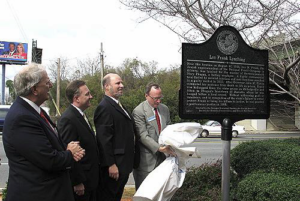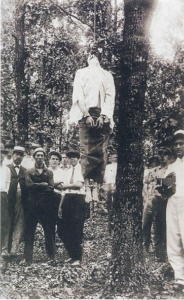
By Jerry Klinger

MARIETTA, Georgia — It was reported by a member of the lynching party; Leo Frank met his death with unexpected composure. A Georgia court had found him guilty of the murder of 13-year old Mary Phagan. She was an employee at the National Pencil Factory Frank managed in Atlanta.
Frank was a prominent member of the Jewish community, a past president of Atlanta’s B’nai B’rith. The evidence against him was flimsy, mainly circumstantial. The Police investigation was seriously flawed. The principal witness against Frank was John Conley, a man with a very strong incentive to accuse Frank of the murder. It diverted attention from himself.
On many levels, Frank’s trial was a first. It was the first time that a Georgia jury accepted the testimony of a Black man condemning a White man. The trial atmosphere, the thousands waiting outside of the courthouse and especially the Georgia press, sweated anti-Semitism from every pore.
The Judge sentenced Frank to death.
Appeals for reconsideration to the Judge failed. An appeal to the Supreme Court of the United States failed. The last possible appeal was to the Governor of Georgia, John Slaton.
On his last days in office Slaton personally reviewed everything about the Frank trial. He scoured every word of the trial transcript. Slaton visited the crime scene. He sensed something was wrong…he knew justice had gone terribly wrong.
His last few hours in office, Slaton commuted Frank’s death sentence to life imprisonment. Slaton ordered Frank removed far from Atlanta to the relative safety of Georgia’s Milledgeville prison.
Slaton’s political career was over. The thousands of armed Georgians gathered about his home screaming for his blood said so. The militia was called out, machine guns were set up for his safety. Slaton and his wife left Georgia on a very, very extended cruise.
In Marietta, Georgia, where Phagan was from and where she was buried, the leading citizens of Marietta organized themselves into the Knights of Mary Phagan. They stood about the grave of “Little Mary” and swore vengeance.
On April 16, Twenty-five of Marietta’s finest citizens easily snatched Leo Frank from prison. They drove him to Marietta where a rope, a tree and thousands of spectators awaited. They had had too much law and too little justice.
Leo asked his executioners to give his wife, Lucille, his wedding band. The chair was kicked out. The Jew lurched downward, his neck snapping.

All day, gawkers came to see Frank’s lifeless body hanging. Pictures were taken of many smiling faces. Ghoulish bigots looked under the long shirt Leo’s body was clothed in. They wished to see if the stories about the monstrous size of Jewish privates was true.
Pieces of Leo, his fingers, his toes, his manhood were not cut off for souvenirs as frequently happened to Black victims of lynching.
The body was returned to a Jewish morgue in Atlanta. Lucille Frank was given Leo’s wedding band. Leo was buried in New York, in Queens.
Three months later, Thanksgiving 1915, William Joseph Simmons invited the Knights of Mary Phagan to join him atop Atlanta’s Stone Mountain for a Cross Burning punctuated with Bible readings. The Ku Klux Klan was reborn that night. Over the next decade, the Klan grew to over six million members across America.
American Jews everywhere were horrified. The message of lynching was more than successful. Terror, fueled by anti-Semitic hatred in America, was real. Leo Frank had been lynched in an American pogrom.
Between 1860 and 1930 there were over 4,700 documented lynchings in America. More than 3,000 were American Blacks, nearly 1,500 were Whites, Hispanics, Chinese, and unknown numbers of Native Americans. The Mexican government protested on behalf of Mexicans. The Chinese Government protested. The Italian government protested the lynching of Italian immigrants.
Like for American Blacks and Native Americans, no government protested the lynching of the Jew. There was no State of Israel. American Jews could only trust in the American government though again that trust was shaken violently. Just 25 years after Leo Frank’s lynching, the American government did little to save Jewish lives as the Holocaust exterminated European Jewry.
Decades passed. Memory faded. The tree where Leo’s body hung still stood at Frey’s Gin and Roswell Road in Marietta. Mary Phagan’s gravesite became a shrine with continual offerings of little stuffed animals, flowers, and coins. Though infamous, the only lynching of an American Jew was relegated to a few moments in the Georgia public school curriculum and virtually nothing in Jewish education nationally.
Unknown to the Jewish American Society for Historic Preservation (JASHP) at the time, the quiet courage of a local Marietta rabbi, Steven Lebow, refused to let the site of Leo’s tragedy recede into the misty shadows of forgetfulness. With the permission of the modern-day owner of the property, an Evangelical Christian, where a small office building had been constructed, Lebow placed two small commemorative plaques on the 80th and 90th anniversary of Leo’s execution. Otherwise, there was nothing.
In 2004, JASHP contacted the Mayor of Marietta about a historical marker at the Frank lynch site. The mayor thanked JASHP for the contact and responded. Marietta had two markers already, one for Mary Phagan and one at the lynching site. He declined further involvement.
The mayor was right and wrong. There was a marker near the grave of Mary Phagan. The marker at the lynching site was placed by Rabbi Lebow.
In my capacity as founding president of JASHP, I learned that the lynching site was being considered for redevelopment as an off-ramp for I-75. The redevelopment would permanently obliterate the site. However, if a Georgia Historical Society marker was at the site first, by law, after redevelopment, the marker must be replaced as near as possible to the original historical location. In other words, the presence of a GHS marker meant the Leo Frank site could be saved.
Memory is a terrible thing to lose.
I reached out to Rabbi Lebow who warmly received the offer of partnership in the effort. The Georgia Historical Society recognized the high significance of a Leo Frank marker at the lynching site. JASHP agreed to pay for it. The Anti-Defamation League joined as a key partner.
Marietta would not give us marker siting permission. Using political connections, the Georgia Department of Transportation gave us permission to locate the GHS marker within their right of way.
It took three years and unexpected, unusual hoops to be jumped through. In 2007, the first ever State historical roadside marker to remember the Leo Frank lynching was dedicated. And… as anticipated, 2013, the Georgia Department of Transportation removed the marker for the I-75 development.
A few months ago, GDOT contacted JASHP. The marker re-siting was to be completed by summer. GDOT presented a beautiful, respectful re-siting plan. It included a significant walkway, landscaping and prominence. It was a mini “parklette.” GDOT named the site the “Leo Frank Memorial.”
JASHP, the ADL and Rabbi Lebow began to plan for the rededication of the Leo Frank Memorial. A week before our planning meeting began, June 29, 2018, something happened in the United States Senate. The Senate’s three Black Senators, Cory Booker D-N.J., Kamala Harris, D-Cal. and Tim Scott R-S.C. introduced legislation criminalizing lynching as a National Crime. Incredibly it had never been done before.
In consideration of the anti-lynching legislative leadership, JASHP proposed to the rededication committee, transforming the meaning of the Leo Frank Memorial. JASHP proposed adding a new memorial element, a JASHP designed and funded, black granite interpretive memorial for all victims of lynching nationally.
The text was simple.
“In respectful memory of the thousands across America, denied justice by lynching, Victims of hatred, prejudice and ignorance.”
An image of Leo Frank hanging at the site was included with his name underneath.
The committee recommended adopting the Memorial.
Because the new Memorial element was to be sited at the Leo Frank Memorial on GDOT land, we applied to GDOT for permission.
GDOT said no. There was no explanation. It was not a response we expected.
JASHP wrote to the director of GDOT, Meg Pirkle… why???
“The rejection is a doubling of the National tragedy that occurred there” JASHP explained. The Leo Frank site is of major Statewide and National Significance. Our effort is associated with the placement of a Georgia Historical Society marker.
A week later, GDOT responded. The Anti-Lynching Memorial at the Leo Frank site was rejected because of regulations. GDOT policy did not prohibit the Memorial, it prohibited symbols and images. There was no exception policy nor was one going to be created.
After extended discussion, a newly designed Anti-Lynching memorial is being presented to GDOT. We are told it will comply with the policy.
The disquieting, historical image of Leo Frank hanging has been removed. Seven powerful words are added in its place. The Memorial will be done in dramatic Georgia Black granite, polished face with engraved white lettering.
In respectful memory of the thousands across America denied justice by lynching; Victims of hatred, prejudice, and ignorance. Between 1880-1930, ~570 Georgians were lynched. ADL, Jewish American Society for Historic Preservation, Rabbi Steven Lebow, Temple Kol Emeth
Seven new words of text transforms the Leo Frank Memorial. The Memorial will become very personal to all Georgians. Universally, it will become the first American memorial to all victims of lynching, without regard to race, creed or sexual orientation, anywhere in the country.
As letters of support come in, one letter from one long time, fighter for human and civil rights is noted. It is a letter of support from Congressman John Lewis of Atlanta.
Ultimately, lynching victims were denied justice, though “convicted” by “legal” and “Popular Justice” Courts. Maybe Georgia should do something much bigger? Perhaps those victims should be pardoned posthumously?
*
Jerry Klinger is president of the Jewish American Society for Historic Preservation. www.JASHP.org